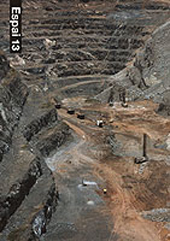- Exhibition program
- Cycle: Angle of vision: 143º
- Artist
- Simon Starling
- Dates
- —
- Curated by
- Montse Badia
Simon Starling (Epson, England, 1967) bases his work on thorough investigation, which includes constant travel, meticulous research and establishing connections between places, objects and historical and cultural circumstances. He often contrasts structures or dynamics, both literally and metaphorically, and concludes with processes that involve the transformation of an object or substance into something else altogether in order to discover unsuspected relations between elements that at first sight appear to be totally unconnected with each other.
His work frequently entails processes and efforts that seem disproportionate in comparison with the aim pursued. In Kakteenhaus/Cactus House (Portikus, Frankfurt, 2002), he transformed the exhibition space into a large greenhouse for a cactus he had brought from the south of Spain. The ideal temperature and level of humidity that the cactus required in order to survive were provided by a car engine also placed in the greenhouse and attached by pipes and cables to a red Volvo parked outside.
Other works of his deal with aspects relating to nationalities, frontiers and the way in which cultural values are defined. For example, in Rescued Rhododendrons (2002), he transported seven rhododendron plants from the north of Scotland (where they are now considered harmful to the ecological balance) to the south of Spain, in a process that reversed the introduction of this plant into Great Britain in the eighteenth century, precisely from Spain.
In Flaga (1972-2000) (2002), Starling used the same process of singularising mass-produced articles in order to make them unique, by driving a red Fiat 126 from Turin to Cieszyn in Poland, where he replaced some of the original bodywork by other pieces manufactured in Poland. With this he exemplified, in the most complicated and artisan way possible, not only passages of a political and industrial history shared by Italy and Poland but also a globalisation that often involves the search for new markets and cheaper labour.
Other works by Starling contain references to the Modern Movement and to the failure of its utopias, in an attempt to recover that ideological impulse. He therefore creates hand-made replicas, produced from discarded materials, lamps (Home-made Henningsen, PH5, 2001) and other objects that, although they were originally designed as democratic improvements to our living conditions, with time have become exclusively collector’s items.
Exposition, the project that Starling has designed specifically for the Espai 13, contrasts contemporary state-of-the-art technology with the evolution of the Modern Movement, taking as a reference point the 1929 International Exhibition in Barcelona, which was a real showcase of German design and technological advances of the period, with splendid displays created by Lilly Reich.
The basis of Exposition is a precious metal, platinum, which has a dual presence in the Espai 13: in the photographs affixed to the wall – which show images of the designs created by Lilly Reich for the German engineering pavilion at the 1929 Exhibition, obtained from platinum prints (a process widely used between 1860 and 1920) – and in the lighting for the photographs, using a fuel cell running on hydrogen, in which platinum is an essential element since it acts as a catalyst for the reaction between the hydrogen and oxygen that produces the energy.
The photographs and the generator are separated by a gently curved smoked-glass partition that is in fact an appropriation of Lilly Reich’s designs for the Barcelona Exhibition. In the Espai 13, the glass is also a translucent mirror, on the distorted surface of which the two elements are visually fused.
In this way, the contradictions between two historical and geographical moments are merged and contrasted: on the one hand, the failure of the utopias of the Modern Movement, whose aesthetic has come down to us stripped of the ideological drive on which it was based, and on the other hand, the present difficulties in implementing the more revolutionary technologies – such as alternative forms of generating energy – partly because of the high cost of the platinum that is essential in order to make them work.
The title of Exposition refers not only to the 1929 International Exhibition in Barcelona but also to the exhibitions that present the latest technological innovations, and to Simon Starling’s own exhibition, which emphasises not only the contradictions of the Modern Movement but also those of the present day. With his painstaking research and surprising juxtapositions, Starling questions cultural values in relation both to the past and to our present.
Montse Badia
April 2004.
With the cooperation of:
Abelló Linde, Arxiu Fotogràfic de l’Arxiu Històric de la Ciutat de Barcelona, Ballard, Cricursa and Daimler Chrysler, 31 Studio
Acknowledgements:
Ferran Figuerola, Andreas M. Kaufmann, Maria Mena, Thomas Neubauer, and the neugerriemschneider gallery, Berlin.


